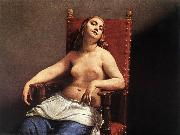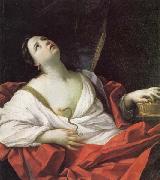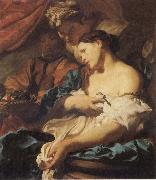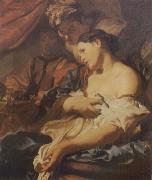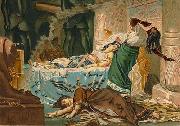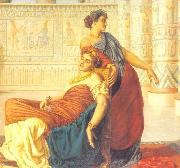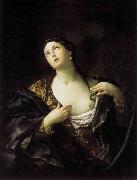Wholesale Oil Painting No Minimum |
|||||||||||
|
|
|||||||||||

|
|||||||||||
|
|
|
||||||||
CAGNACCI, GuidoItalian Baroque Era Painter, 1601-1681 |
||||||||
|
|
||||||||
The Death of Cleopatra
The Death of Cleopatra Painting ID:: 5539 |
c. 1660
Oil on canvas, 120 x 158 cm
Pinacoteca di Brera, Milan c. 1660 Oil on canvas, 120 x 158 cm Pinacoteca di Brera, Milan |
|||||||
|
|
||||||||
RENI, GuidoItalian Baroque Era Painter, 1575-1642 Italian painter, draughtsman and etcher. He was one of the greatest and most influential of the 17th-century Italian painters, whose sophisticated and complex art dominated the Bolognese school. A classicizing artist, deeply influenced by Greco-Roman art and by Raphael but also by the mannered elegance of Parmigianino's paintings, he sought an ideal beauty; his work was especially celebrated for its compositional and figural grace. In his religious art he was concerned with the expression of intense emotion, often charged with pathos; according to his biographer Malvasia, he boasted that he 'could paint heads with their eyes uplifted a hundred different ways' to give form to a state of ecstasy or divine inspiration. |
||||||||
|
|
||||||||
|
|
The Death of Cleopatra
The Death of Cleopatra Painting ID:: 28119 |
mk61
c.1635
Oil on canvas
110x94cm
mk61 c.1635 Oil on canvas 110x94cm |
||||||
|
|
||||||||
LISS, JohannGerman Baroque Era Painter, ca.1597-1631 |
||||||||
|
|
||||||||
|
|
The Death of Cleopatra
The Death of Cleopatra Painting ID:: 33620 |
mk86
c.1622-1624
Oil on cavas
97.5x85.5cm
Munich,Bayerische mk86 c.1622-1624 Oil on cavas 97.5x85.5cm Munich,Bayerische |
||||||
|
|
||||||||
LISS, JohannGerman Baroque Era Painter, ca.1597-1631 |
||||||||
|
|
||||||||
|
|
The Death of Cleopatra
The Death of Cleopatra Painting ID:: 55740 |
mk244
c.1622-1624
Oil on canvas
97.5x85.5cm
mk244 c.1622-1624 Oil on canvas 97.5x85.5cm |
||||||
|
|
||||||||
Felice FicherelliItalian painter , b. 1603, San Gimignano, d. 1660, Firenze Firenze,Italian painter. His most original works were easel pictures, for private collectors, often of cruel and violent subjects, which he interpreted with a morbid sensuality and ambiguous tenderness. He was brought to Florence when very young by the collector Conte Alberto Bardi (d 1632), who arranged for him to study with Jacopo da Empoli and to copy works by Andrea del Sarto. Ficherelli's clear compositions and luminous drapery, which remain evident throughout his career, reflect this training. In the early 1630s he was attracted by the delicate sfumato effects of Francesco Furini and developed a style close to that of Cecco Bravo; his works of this period include the Sacrifice of Isaac (Florence, priv. col., for illustration see Gregori, 1968, p. 26) and the Martyrdom of St Agatha (priv. col., see Cantelli, fig. 338). There followed in the late 1630s Tarquin and Lucretia, which is known in several versions (e.g. Rome, Accad. N. S Luca), the theatrical Julia Receiving the Bloodstained Garments of Pompey (Genoa, priv. col., see 1986 exh. cat., pl. 1.208), an Allegory of Patience (Florence, Bigongiari priv. col., see Gregori, 1974, fig. 23) and Antiochus and Stratonica (Auckland, C.A.G.). |
||||||||
|
|
||||||||
|
|
The Death of Cleopatra
The Death of Cleopatra Painting ID:: 80430 |
1650s
Medium Oil on canvas
cyf 1650s Medium Oil on canvas cyf |
||||||
|
|
||||||||
Juan LunaJuan Luna y Novicio (October 23, 1857 - December 7, 1899) was an Ilocano Filipino painter, sculptor and a political activist of the Philippine Revolution during the late 19th century. He became one of the first recognized Philippine artists. His winning the gold medal in the 1884 Madrid Exposition of Fine Arts, along with the silver win of fellow Filipino painter Felix Resurreccien Hidalgo, prompted a celebration which was a major highlight in the memoirs of members of the Propaganda Movement, with the fellow Ilustrados toasting to the two painters' good health and citing their win as evidence that Filipinos and Spaniards were equals. Regarded for work done in the manner of the Spanish and French academies of his time, Luna painted literary and historical scenes, some with an underscore of political commentary. |
||||||||
|
|
||||||||
|
|
The Death of Cleopatra
The Death of Cleopatra Painting ID:: 83531 |
The Death of Cleopatra (Spanish: La Muerte de Cleopatra), a painting by Juan Luna.
Date 1881(1881)
cjr The Death of Cleopatra (Spanish: La Muerte de Cleopatra), a painting by Juan Luna. Date 1881(1881) cjr |
||||||
|
|
||||||||
Valentine Cameron Prinsep PrintsIndian-born British Pre-Raphaelite Painter, 1838-1904 Henry Prinsep was an intimate friend of G. F. Watts, under whom his son first studied. Val Prinsep also worked in Paris in the atelier Gleyre; and 'Taffy' in his friend George du Maurier's novel Trilby, is said to have been sketched from him. He was an intimate friend of John Everett Millais and of Burne-Jones, with whom he travelled in Italy. He had a share with Rossetti and others in the decoration of the hall of the Oxford Union. Prinsep first exhibited at the Royal Academy in 1862 with his Bianca Capella, his first picture, which attracted marked notice, being a portrait (1866) of General Gordon in Chinese costume. Princep lent the costume to Millais who used it in his own painting Esther. The best of his later exhibits were A Versailles, The Emperor Theophilus chooses his Wife, The Broken Idol and The Goose Girl. He was elected A.R.A. in 1879 and R.A. in 1894. In 1877 he went to India and painted a huge picture of the Delhi Durbar, exhibited in 1880, and afterwards hung at Buckingham Palace. |
||||||||
|
|
||||||||
|
|
The Death of Cleopatra
The Death of Cleopatra Painting ID:: 90895 |
oil on canvas
cjr oil on canvas cjr |
||||||
|
|
||||||||
Guido Reni1575-1642 Italian Guido Reni Galleries Born in Bologna into a family of musicians, Guido Reni was the son of Daniele Reni and Ginevra de?? Pozzi. As a child of nine, he was apprenticed under the Bolognese studio of Denis Calvaert. Soon after, he was joined in that studio by Albani and Domenichino. He may also have trained with a painter by the name of Ferrantini. When Reni was about twenty years old, the three Calvaert pupils migrated to the rising rival studio, named Accademia degli Incamminati (Academy of the "newly embarked", or progressives), led by Lodovico Carracci. They went on to form the nucleus of a prolific and successful school of Bolognese painters who followed Annibale Carracci to Rome. Like many other Bolognese painters, Reni's painting was thematic and eclectic in style. By late 1601, Reni and Albani had moved to Rome to work with the teams led by Annibale Carracci in fresco decoration of the Farnese Palace. During 1601-1604, his main patron was cardinal Sfondrato. By 1604-1605, he received an independent commission for an altarpiece of the Crucifixion of St. Peter. After a few year sojourn in Bologna, he returned to Rome to become one of the premier painters during the papacy of Paul V (Borghese). From 1607-1614, he was one of the painters patronized by Borghese. Abduction of Deianira, 1620-1621.Reni's frescoed ceiling of the large central hall of garden palace, Casino dell'Aurora located in the grounds of the Palazzo Pallavicini-Rospigliosi, is considered his masterpiece. The casino was originally a pavilion commissioned by Cardinal Scipione Borghese; the rear portion overlooks the Piazza Montecavallo and Palazzo del Quirinale. The massive fresco is framed in quadri riportati and depicts Apollo in his Chariot preceded by Dawn (Aurora) bringing light to the world. The work is restrained in classicism, copying poses from Roman Sarcophagi, and showing far more simplicity and restraint than Carracci's riotous Triumph of Bacchus and Ariadne[5] in the Farnese. Reni in this painting is allies himself more with the sterner Cavaliere d'Arpino,Lanfranco, and Albani "School" of mytho-historic painting, and less with the more crowded frescoes characteristic of Pietro da Cortona. There is little concession to perspective, and the vibrantly colored style is antithetical to the tenebrism of Caravaggio's followers. Payments showed that he was paid in 247 scudi and 54 baiocchi upon completion on 24 September 1616. He also frescoed in Paoline Chapel of Santa Maria Maggiore in Rome as well as the Aldobrandini wings of the Vatican. According to rumor, the pontifical chapel of Montecavallo (Chapel of the Annuciation) was assigned to Reni to paint. However, because he felt underpaid by the ministers, the artist left for Bologna, leaving the role of the preeminent artist in Rome to Domenichino. |
||||||||
|
|
||||||||
|
|
The Death of Cleopatra
The Death of Cleopatra Painting ID:: 95468 |
between 1625(1625) and 1630(1630)
Medium oil on canvas
cyf between 1625(1625) and 1630(1630) Medium oil on canvas cyf |
||||||
|
|
||||||||
|
Guido Reni 1575-1642 Italian Guido Reni Galleries Born in Bologna into a family of musicians, Guido Reni was the son of Daniele Reni and Ginevra de?? Pozzi. As a child of nine, he was apprenticed under the Bolognese studio of Denis Calvaert. Soon after, he was joined in that studio by Albani and Domenichino. He may also have trained with a painter by the name of Ferrantini. When Reni was about twenty years old, the three Calvaert pupils migrated to the rising rival studio, named Accademia degli Incamminati (Academy of the "newly embarked", or progressives), led by Lodovico Carracci. They went on to form the nucleus of a prolific and successful school of Bolognese painters who followed Annibale Carracci to Rome. Like many other Bolognese painters, Reni's painting was thematic and eclectic in style. By late 1601, Reni and Albani had moved to Rome to work with the teams led by Annibale Carracci in fresco decoration of the Farnese Palace. During 1601-1604, his main patron was cardinal Sfondrato. By 1604-1605, he received an independent commission for an altarpiece of the Crucifixion of St. Peter. After a few year sojourn in Bologna, he returned to Rome to become one of the premier painters during the papacy of Paul V (Borghese). From 1607-1614, he was one of the painters patronized by Borghese. Abduction of Deianira, 1620-1621.Reni's frescoed ceiling of the large central hall of garden palace, Casino dell'Aurora located in the grounds of the Palazzo Pallavicini-Rospigliosi, is considered his masterpiece. The casino was originally a pavilion commissioned by Cardinal Scipione Borghese; the rear portion overlooks the Piazza Montecavallo and Palazzo del Quirinale. The massive fresco is framed in quadri riportati and depicts Apollo in his Chariot preceded by Dawn (Aurora) bringing light to the world. The work is restrained in classicism, copying poses from Roman Sarcophagi, and showing far more simplicity and restraint than Carracci's riotous Triumph of Bacchus and Ariadne[5] in the Farnese. Reni in this painting is allies himself more with the sterner Cavaliere d'Arpino,Lanfranco, and Albani "School" of mytho-historic painting, and less with the more crowded frescoes characteristic of Pietro da Cortona. There is little concession to perspective, and the vibrantly colored style is antithetical to the tenebrism of Caravaggio's followers. Payments showed that he was paid in 247 scudi and 54 baiocchi upon completion on 24 September 1616. He also frescoed in Paoline Chapel of Santa Maria Maggiore in Rome as well as the Aldobrandini wings of the Vatican. According to rumor, the pontifical chapel of Montecavallo (Chapel of the Annuciation) was assigned to Reni to paint. However, because he felt underpaid by the ministers, the artist left for Bologna, leaving the role of the preeminent artist in Rome to Domenichino. The Death of Cleopatra between 1625(1625) and 1630(1630) Medium oil on canvas cyf |
||||||||
|
|
||||||||
|
Prev Next
|
||||||||
|
|
||||||||
|
Related Paintings to Guido Reni :. |
||||||||
|
|
||||||||
|
CONTACT US |
